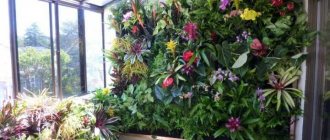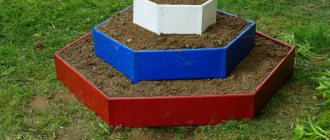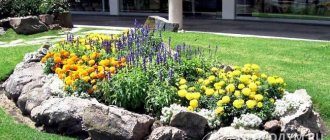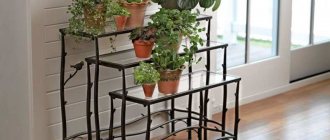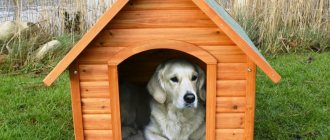A vertical flowerbed for petunia with your own hands has gained great popularity among lovers of growing flowers. This versatile and compact landscaping option will be especially appropriate in small areas. With its help, you can effectively delimit free space and increase the decorative effect of the local area and garden. The best decoration for vertical flower beds is petunia in a variety of shades. Anyone can make such a flower garden with their own hands - you need to know the basic subtleties of creation, what materials to use, and what varieties to grow.
Types of vertical flower beds
In general, it is a vertical structure made of any containers or containers, which ensures the creation of an earthen embankment of this shape. There are several ways to organize a vertical flower bed:
- ground - built from earth and stones, which are laid like a pyramid, such a structure is built on the ground, the usual example is an alpine slide, the structure can be quite large in size;
- near-wall - the basis of the structure is a frame that is fixed to the wall, an example of which can be an ordinary screen with climbing plants, this is how the walls of a building, gazebos, and fences are decorated;
- hanging models - the basis is a container where you can grow flowers: a pot, box, bucket, container is hung on strings or secured with rods, such a flower bed is small in size, but it can be arranged anywhere: on a wall, on a fence, on a tree, in the porch opening or on the veranda;
- wall-mounted - it is recommended to make a vertical flower bed with petunia just like this, since the design is intended for low-growing plants with an underdeveloped root system; this category includes all possible types of beds that can be mounted on a wall, but in fact it can take up much more space in length than in height.
Important! Not all plants are suitable for most vertical flower beds. As a rule, there is quite a bit of soil in containers, so only plants with a compact root system and not reaching great heights can grow and bloom here.
"Exhibition"
Let petunias become showpieces in your collection. Create galleries, platforms, and podiums in the garden. It is best if the construction materials in the “halls” are different. Try to decorate the garden structures in light colors, just like the walls on the vernissage. Visitors will come to look at your paintings. They will be both various compositions from individual petunias, and their combinations with decorative foliage plants, cereals, as well as with stones, fountains, garden accessories and furniture.
Frame some of the compositions like real paintings, enclosing them in frames of different sizes. Secure the frame (stand or lay it down) so that the desired plant composition is inside it.
The “sculptures” at your opening day will be petunias presented in vertical gardening: on trellises, in hanging baskets, on special stands and pedestals. Try to provide a wide variety of varieties. To ensure that flowers in such a company have a truly stunning appearance, use natural biostimulants.
Vertical gardening. Photo: Olga Voronova
Advantages and disadvantages
A vertical flower bed of petunias or any other suitable plants has many advantages compared to a conventional horizontal bed:
- a vertical flowerbed takes up a minimum of space, a hanging structure takes up no space at all;
- such a compact option is very easy to water, for this there is no need to pull a long hose, but it largely depends on the design: a hanging container needs to be watered manually and each separately, a vertical model based on a chain-link mesh or bag is irrigated by installing a watering pipe inside, and so on Further;
- containers for flowers are easy to clean and wash; for the winter, the vertical flower bed is dismantled and left to be stored in the cellar; reassembling any of these models is not difficult;
- the appearance of the structures is determined solely by the imagination and capabilities of the dacha owner; home craftsmen offer a lot of very original design options that can transform the appearance of any yard or dacha;
- It is easy to move the flowerbed to another place right when the petunias are blooming.
This solution also has disadvantages:
- although it is easier to care for the garden bed, it needs more frequent watering, the volume of soil here is small, and it dries out quite quickly;
- for the same reasons, petunias or other plants should be fed more often, since a small volume of soil quickly becomes poor.
The service life and timing of construction are determined by the design of the vertical flower bed and the materials used.
Petunia varieties for vertical flower beds
Petunias are one of the most popular plants for flower garden decoration. Perennial in nature and annual in floriculture, the plant produces fairly large flowers of various shades: white, cream, yellow, red, blue, light blue, violet. On two-color plants, the petals have a border, inserts, and a star of a different color. Such amazing diversity allows you to create flower beds of exceptional attractiveness.
Important! For a vertical flower bed, only varieties of petunias that grow no more than 30 cm in height are suitable.
Suitable varieties can be selected from any variety of petunias:
- Multiflora - plants with relatively small flowers that appear in large numbers. Petunia perfectly tolerates extreme heat, rain, sudden cold snaps, and open sun. These varieties are ideal for flower beds, as they do not require careful care.
- Large-flowered - usually double or fringed. The diameter of the flower can reach 12 cm in diameter. This is a very beautiful variety of petunia, but very sensitive to rain. If the flower bed is exposed to heavy rain, the flowers are damaged and lose their attractiveness. For vertical beds, large-flowered petunias are used only when they organize hanging structures on balconies or terraces, where the flowers are protected from rain.
- Floribunda - its flowers are smaller than those of large-flowered ones, but there are almost as many of them as those of multi-flowered ones. The variety of colors and unpretentiousness make varieties of this category most suitable for a vertical flower bed of any type.
- Ampelous is a favorite type of petunias for landscape decoration. The meter-long stems of the plant produce a variety of flowers and serve as the basis for flower beds of any kind. It is easy to build a vertical flower bed of ampelous petunias with your own hands if you use a frame structure. Hanging varieties from hanging varieties are created less frequently.
- Surfinia is another type of petunia with long stems - up to 2 m. They are used for organizing vertical and horizontal beds of any type, except for hanging structures. Flowers reach a diameter of 6 to 9 cm and come in any color except orange and yellow.
- Terry - the petals of terry petunia have a specific corrugated structure. They are very beautiful, forming lush multi-colored inflorescences. This is ideal for borders and vertical flower beds. Double flowers are unpretentious: they are not afraid of the heat of the sun and heavy rain.
- Cascade - the stems of the plant reach a length of 1 and 1.5 m, but unlike ampelous petunia, the stems grow not only downwards, but also to the sides. This option is suitable for all types of vertical structures, including suspended ones.
The choice of variety depends on the preferences of the owner. A variety of colors and combinations of shades allows you to choose a “bouquet” for every taste.
Popular varieties
The plant variety is selected based on the size of the flowerbed and your own preferences. Among all the variety of petunias you can even find black flowers.
- Fantasy - 9 hybrids with small flowers - up to 4 cm in diameter, red with white veins, soft pink, blue-violet, raspberry and cream. The height of the plant does not exceed 20 cm, so the variety is perfect for hanging structures.
- Plumcrystals - 13 hybrids with flowers with a diameter of 6 to 9 cm. The color range includes burgundy, white, lilac, pink with veins. The height of the plant does not exceed 30 cm.
- Charm is a multi-flowered annual plant up to 25 cm high. Petunia blooms from July until September. An attractive feature of the variety is its wide variety of shades.
- Pikoti - red, purple, crimson, pink flowers with white edging of petals. They belong to the terry category and are very beautiful.
- Tumbelina - Japanese petunia. The flowers are small, densely double, with dark veins clearly visible on the light petals. The variety is very refined.
- Ramblin is a cascade variety. Straight shoots reach a height of no more than 35 cm, and the length of the side shoots is 1 m. The flowers are large, semi-double, peach-pink in color. There are also red, white and lilac. It should be grown in fairly large pots - up to 10 liters.
- Sonata is a cascading terry variety. Petunia blooms 2 weeks earlier than other species and blooms for a long time. Luxurious double white “stars” appear on both straight and hanging side stems.
- Pirouette - very large double flowers, pink or burgundy with a white edge. The flowerbed is literally hidden under a canopy of flowers.
Important! For vertical flower beds, it is preferable to choose hybrids, since perennial petunias still require more land than annual ones. Therefore, they do not grow very well in such beds.
Growing seedlings
The secret of success is proper planting and rational care. Petunias grow quickly, spreading to the sides, eventually hanging down to a length of 40-100 centimeters. Cultivation begins with planting or purchasing seedlings. Seedlings are planted in mid-May (less risk of frost) in fertile soil in a sunny place.
Important! Petunias are very sensitive to weather conditions!
Growing the plant is not suitable for beginners, but the efforts will certainly pay off with beautiful flowering that lasts throughout the season until the first frost.
When to plant seedlings?
To create flower beds, annual plants are often used (with the exception of planting trees and shrubs in large pots), characterized by a long germination period and low resistance to temperature fluctuations. The first planting of plants on seedlings, taking into account the “summer” flowering, begins in February!
Petunia is a rather sensitive plant. It is better to ensure “wintering” in greenhouse conditions; by May the plant will become much more developed than its counterparts located outside the greenhouse.
Transplanting seedlings
The secret to exceptionally lush plants is replanting in late May or early June. Planting takes place in small plastic pots, where the flowers can grow freely and the root system is effectively protected from the cold. In order for the effect to persist after transplanting into the final pot, you first need to slightly moisten the flower, and then place it exactly at the same depth as the seed pot - then the plant will not be “shocked”. Frequent watering twice a day will ensure consistent conditions over the following weeks.
For convenience, before boarding, you should choose one of the options:
It is very important before planting any container: flower pot, flower towers or lawn, to always remove the “old” soil to reduce the risk of disease and parasite transmission. The old soil is replaced with peat.
Top dressing
Seasonal plants recommended for urban planting require intensive feeding. A special mixture of fertilizers will be required, constantly supplied to the roots. For petunia, synthetic fertilizers are applied in low concentrations (0.1%), applied maximum every 2 weeks directly to the substrate. For the best effect, apply multi-component fertilizer every 7-10 days (especially for blooming flowers, not nitrogen).
How to make a vertical petunia flowerbed
A variety of designs also implies a variety of methods. You can arrange a vertical flower bed with your own hands using many methods. In most cases, this does not require any costs, since it is constructed from any available materials.
From the grid
A chain-link mesh with small cells serves as the basis for a wide variety of garden designs. The material is easy to cut, twist and fasten. There are several options for arranging a flower bed.
The easiest way to make vertical petunia beds from a chain-link mesh is to build an earthen “tower” from mesh and agrofibre.
A mesh fragment of the required size is rolled into a cylinder and secured. Then the inside of the structure is lined with agrofibre and fixed to the frame. Install the structure at any chosen location. Drainage - sand and gravel - is poured into the bottom. Then fix a watering pipe in the center of the future flowerbed - a piece of hose or plastic pipe with holes, and fill the bed with prepared soil.
The flowerbed is watered so that the soil settles. Then holes are made in the cells in the agrofibre - preferably in a checkerboard pattern, and petunias are planted in the resulting holes. Flowers are also planted at the end of the bed.
Another option is possible - more decorative. Step-by-step instructions for making a vertical petunia bed include the following steps.
2 fragments of a chain-link mesh of the same size are twisted into a cylinder or something like a snail so that the meshes are at a short distance from each other. Between the meshes they are fastened with wire so that this distance is maintained. The design can be given essentially any shape, the basis of which is a spiral.
Decorative stones - identical or different - are placed between the grids. The stones must be quite large so as not to fall out, so for such a product they choose a mesh with very small cells.
Soil is laid inside the cylinder or spiral, corresponding to the height of the flowerbed wall. This is where plants are planted. Be sure to place drainage at the bottom of the structure.
Water such a flower bed in the usual way - from hoses or a watering can. Moreover, there is quite a lot of land here, so the flower garden does not need frequent watering.
A DIY vertical flower bed of petunias is shown in the video.
From a plastic pipe
Plastic pipes are the basis for a wide variety of garden crafts. Vertical flower beds of various designs are made from this material.
The wall-mounted version, for example, is made like this.
Plastic pipes - preferably polypropylene, are divided into the required number of fragments. Then each segment is cut into 2 parts lengthwise. The ends of the pipes are closed with plugs, holes are made in the pipes in the form of a circle or semicircle - petunias will be planted here.
The prepared sections are fixed on the wall, on the fence using self-tapping screws and clamps, or hung on hooks. Then the prepared soil is filled into the resulting containers, and plants are planted in the holes.
You can make a structure of another type - ground-based. It will require pipes of different diameters: the larger one is used as a frame for the garden bed, and the smaller diameter one becomes a watering pipe.
Holes are drilled in the pipes. Small holes are made in the sprinkler. Large holes are made in a pipe with a large diameter.
A large diameter pipe is dug into the ground or secured in any other way. A pipe of smaller diameter is wrapped with agrofibre or burlap: this is necessary so that the soil does not wash out during watering.
Then the irrigation tube is inserted into a larger one and the structure is covered with soil. Petunia seeds are added to the substrate. Growing plants find their way to the hole themselves.
The plastic pipe option is considered optimal for growing multi-flowered petunia varieties.
From flower pots or flowerpots
Flower pots are an excellent basis for a vertical flower bed. Pots are used in a variety of combinations.
The simplest and most obvious is the device of a flower pot. The pot is tied with twine or rope, or even decorative tying is done using the macrame method and the pot is hung in any convenient place: on the balcony, in the entrance opening on the veranda, on the wall of the building, on tree branches. Layers of sand and soil are poured into a flowerpot and petunias are planted. Cascading varieties are best suited for suspended structures.
A vertical flower bed can be made differently. For this design, several pots of different diameters are collected and assembled into a kind of pyramid. The largest pot is filled with soil, a flowerpot with a smaller diameter is inserted into it, also filled with soil and the next one is inserted. To strengthen the structure, the pots are mounted on a metal or wooden rod. For it, holes are first made in the flowerpots. Petunias are sown in open ground in pots. Multi-flowered petunias are selected for the flower bed.
A more complex option is a frame in the form of a metal main pole on which the holders are attached. Flowerpots with petunias are placed in them. This flowerbed differs from the indoor model only in size and higher strength. Plants can be planted of any variety.
Important! It is preferable to use plastic pots: they are noticeably lighter, easy to clean, and can easily withstand changes in temperature and humidity.
From wooden boxes or pallets
A container such as a box, wooden or plastic, has been used as a flower bed for a long time. Strictly speaking, this is not a vertical structure, but it can be used to make one.
A wooden frame is made that can serve as a base. Burlap is placed at the bottom of the box, then a layer of sand and gravel and soil prepared for the flower bed. Seeds can be mixed with soil, or seedlings can be planted. The variety of petunia does not matter. The boxes are secured to a wooden frame or to a fence.
As a rule, a wall-mounted version is made from pallets, since such a structure requires support. For a flower bed, the open part of the tray is covered with agrofibre or burlap, and watering tubes are placed inside: another method of watering is very difficult.
Then the pallet is installed vertically, the top side is removed and the narrow structure is covered with soil and seeds. Petunias sprout from the holes.
From bags
A bag made of plastic, burlap or even agrofibre is used as a base. The design is extremely simple, but not nearly as decorative as, for example, hanging models or even options made from plastic pipes.
The principle is simple: the bag is filled with prepared soil. Holes are made in the walls, into which petunias are then planted. Instead of 1 large bag, you can use several smaller and more decorative ones. In them the plant is planted only from above.
From tires
An ordinary car tire can also serve as a base for a vertical flower bed. This option allows you to arrange bulk beds in any part of the yard, for example, in the middle of an asphalt area.
The tire is placed in the chosen place, a layer of drainage is poured, then soil is added and petunias are planted. Water the garden bed as usual. If desired, you can make a high bed - in this case, several tires are laid on top of each other.
You can make a pyramidal structure or another shape. In this case, tires of different sizes are selected. The largest tire is placed on the ground and covered with earth. Then they lay down a smaller tire and also cover it with soil. The operation is repeated until all the tires are laid in the form of a pyramid. Petunia is sown in open areas of land on each tier.
You can water a vertical flower bed with petunia either in the usual way, or by installing a watering pipe during assembly of the structure.
To make the flower garden more attractive, the tires are given an unusual configuration.
From bottles
Plastic bottles in the country find a wide variety of uses. They are also used to create flower beds.
To do this, a fairly wide hole is cut out of the bottle so that the plant can be watered, but it should not occupy more than 1/3 of the body. Cutting bottles in half is impractical: the volume of soil is too small to grow a flower. Prepared soil is poured into the bottle and petunias are planted. It is preferable to use small-flowered ones, since they have the most compact root system.
The bottles are placed horizontally on the wall of the building. Bottles can be mounted on a fence or on a door in a vertical position. In this case, cut off the third part of the bottle with the bottom. However, such a container is even smaller in size and allows you to plant literally 1 flower at a time.
From an old barrel
An old barrel can also serve as a base. It is better to use a wooden or plastic barrel for this. Metal needs periodic painting and cleaning, as it is prone to rust. Yes, and working with such material is more difficult.
A vertical flower garden is built on the principle of mesh flower beds. They make holes in the barrel in a checkerboard pattern, then fill the barrel with earth and plant petunias in the hole and on the open ground.
Other options
Petunias are often unpretentious and very lush plants. During flowering, the base of the flowerbed becomes almost invisible behind the flowers. This makes it possible to use such seemingly unsightly options as chain-link mesh or a plastic barrel for flower beds. However, other items that can create an original design can also be used:
- old chest of drawers - furniture drawers are covered with soil, pulled out to different lengths and petunia is planted in open areas of the ground, this design looks very interesting on the veranda;
- shoes - especially rubber boots, which can also be painted, a great idea for a “children’s” flower bed;
- popular today for decoration is a non-working bicycle with window boxes attached to it; petunia is planted in containers, and the “bicycle” serves as the basis for a decorative solution.
The basis can also be other household items: a bathroom, a shelving unit, a kettle, dishes.
From containers
You can also organize an original flower bed using flower containers. You can do it in two ways. For the first, you need reinforcement that is driven into the ground, a flower pot is put on it, soil is poured in and the plant is planted. The next pot is put on at an angle relative to the first.
So the steps are repeated until the top of the reinforcement. Instead of reinforcement, you can use twine or wire, then the upper end should be hung somewhere.
Important! For such structures, it is recommended to use a light substrate so as not to overload the already shaky structure.
The second method is suitable if there is an old dried tree on your site. You need to remove all the branches from it and leave only part of the trunk, onto which the containers are attached using self-tapping screws.
Caring for petunias in vertical flower beds
This method of planting does not make it difficult to care for the flower garden so that the petunias grow lushly and richly. You need to follow a few simple rules:
- when planting plants, a distance of 15 to 30 cm should be maintained between flowers, the distance depends on the variety;
- water the flowers once every 1–2 days, in the morning or evening; during the day, watering is allowed only if the flowerbed is located in the shade;
- You need to feed a vertical petunia flowerbed with liquid fertilizers during flowering and periodically during the summer;
- faded flowers and wilted leaves should be removed so that new buds appear faster;
- on cascading and ampelous petunias, long shoots need to be pinched up to 4 buds;
- Terry large-flowered varieties should be moved under a canopy during rain.
Important! During growth, petunia is fed with nitrogenous fertilizers, and during the flowering period - with potassium and phosphorus.
